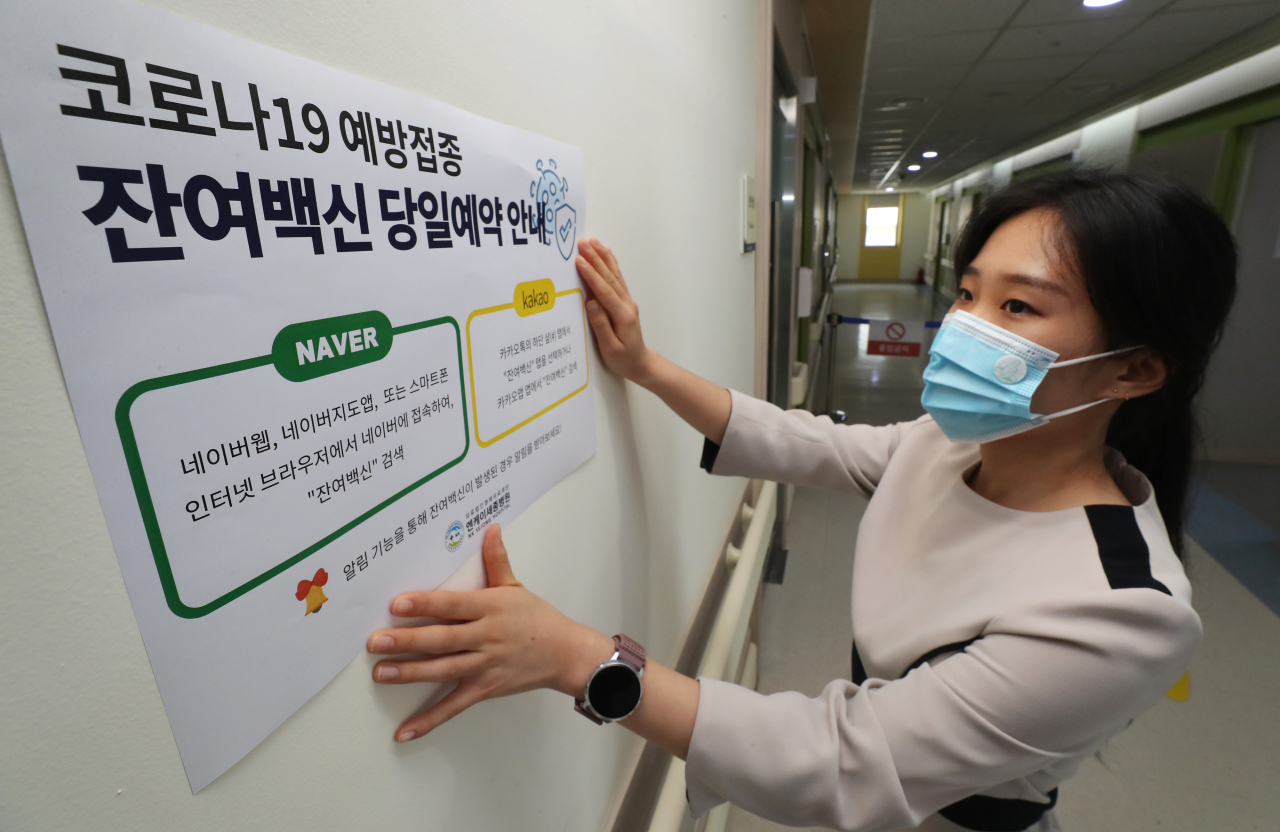 |
A medical worker posts instructions on applying for leftover COVID-19 shots through popular mobile platforms, such as Naver and Kakao, at a hospital in the central city of Sejong on Thursday. (Yonhap) |
South Korea's new daily coronavirus cases fell below 600 on Friday, but sporadic cluster infections traced to entertainment facilities still hampered the virus fight, sparking concerns over yet another uptick in additional cases.
The country reported 587 more COVID-19 cases, including 571 local infections, raising the total caseload to 138,898, the Korea Disease Control and Prevention Agency (KDCA) said.
The daily caseload stood at 629 cases the previous day after reporting a nearly two-week high of 707 on Wednesday.
There were three additional virus deaths, raising the total to 1,946. The fatality rate came to 1.4 percent.
Amid sporadic cluster infections nationwide, daily caseloads have been stuck in a tight range since late March with no significant signs of a letup, going through some ups and downs between the 400s and 700s.
Cluster infections from entertainment facilities especially continued to disrupt authorities' efforts to flatten the curve.
A hotel bar in Daegu, 302 kilometers south of Seoul, has reported 207 infections since mid-May. Another group of 34 patients were traced to a bar in South Gyeongsang Province.
The country is revving up its inoculation program to create herd immunity by November.
A total of 4.68 million people, or 9.1 percent, have received at least their first shots of COVID-19 vaccines, up 657,192 from the previous day. AstraZeneca's vaccine has been given to 2.64 million people, while 2.03 million have received that of Pfizer.
The country, which launched its vaccine rollout in late February, aims to vaccinate 13 million people by the end of June. So far, the country has completed vaccinations for some 4 percent of its 52 million population.
South Korea plans to allow people who have received their first jabs to take their masks off outdoors starting in July as its first step to normalize people's everyday lives.
The KDCA said its study carried out from January to April on 2,248 South Koreans showed that only 0.27 percent of people had developed antibodies against COVID-19.
Of the locally transmitted cases, 212 came from Seoul and 146 from the surrounding Gyeonggi Province.
The southeastern city of Daegu added 24 new patients, and Incheon, located west of Seoul, identified 26 more.
Imported cases came to 16, raising the total to 8,991.
Of the imported cases, the Philippines accounted for five, followed by India and the United States with three each.
The number of patients in serious or critical condition came to 156, up two from the previous day.
Over the past two weeks, around 27 percent of the newly added patients had unknown transmission routes. Cluster infections accounted for 23 percent as well.
The total number of people released from quarantine after making full recoveries was 128,761, up 581 from a day earlier. Around 92.7 percent of the patients reported here were cured.
South Korea carried out 9,702,456 COVID-19 tests since January last year, including 36,763 from the previous day. (Yonhap)




![[Herald Interview] 'Trump will use tariffs as first line of defense for American manufacturing'](http://res.heraldm.com/phpwas/restmb_idxmake.php?idx=644&simg=/content/image/2024/11/26/20241126050017_0.jpg)

![[Health and care] Getting cancer young: Why cancer isn’t just an older person’s battle](http://res.heraldm.com/phpwas/restmb_idxmake.php?idx=644&simg=/content/image/2024/11/26/20241126050043_0.jpg)

